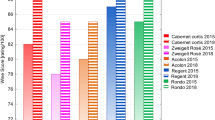Abstract
In order to study the magnitude of the copigmentation phenomenon in aged red wines, 84 samples of Listán negro wines were collected from several wineries in the Canary Islands. They were analysed at 1 and 2 years of age. The contribution of free anthocyanins, copigmented anthocyanins and polymeric pigments to the colour of wine, and the total phenols were determined. Moreover, coloured anthocyanins, total anthocyanins, percentage of total anthocyanins in coloured form and chemical age factor, and the chromatic characteristics of the wines were determined.
The contribution to colour due to copigmented anthocyanins in these aged red wines remained at 22.3 and 18.5% (mean values) after 1 and 2 years of age, respectively, and the free anthocyanins at 37.0 and 32.5%. A comparison between the results obtained by Somers and Boulton methods has been established.
Similar content being viewed by others
References
Boulton RB, Singleton VL, Bisson LF, Kunkee RE (1996) Principles and practices of winemaking. The Chapman & Hall Enology Library, New York
Flanzy C (1999) Oenologie: Fondements scientifiques et technologiques. Technique et Documentation, Paris
Boulton RB (2001) The copigmentation of anthocyanins and its role in the color of red wine. A critical review. Am J Enol Viticult 52:67–87
Darias-Martin J, Carrillo M, Díaz E, Boulton RB (2001) Enhancement of red wine colour by pre-fermentation addition of copigments. Food Chem 73:217–220
Darias-Martín J, Martín-Luis B, Carrillo-López M, Lamuela-Raventós R, Díaz-Romero C, Boulton RB (2002) Effect of caffeic acid on the color of red wine. J Agric Food Chem 50:2062–2067
Bloomfield DG, Heatherbell DA, Pour Nikfardjam MS (2003) Effect of p-coumaric acid on the colour in red wine. Mitteilungen Klosterneuburg 53:195–198
Schwarz M, Picazo-Bacete JJ, Winterhalter P, Hermosín-Gutiérrez I (2005) Effect of copigments and grape cultivar on the color of red wines fermented after the addition of copigments. J Agric Food Chem 53:8372–8381
Brouillard R, Mazza G, Saad Z, Albrecht-Gary AM, Cheminat A (1989) The copigmentation reaction of anthocyanins: a microprobe for the structural study of aqueous solutions. J Am Chem Soc 111:2604–2610
Brouillard R, Dangles O (1994) Anthocyanin molecular interactions: the first step in the formation of new pigments during wine aging? Food Chem 51:265–271
Baranac JM, Petranovic NA, Dimitric-Markovic JM (1996) Spectrophotometric study of anthocyan copigmentation reactions. J Agric Food Chem 44:1333–1336
Baranac JM, Petranovic NA, Dimitric-Markovic JM (1997) Spectrophotometric study of anthocyan copigmentation reactions. 2. J Agric Food Chem 45:1694–1697
Baranac JM, Petranovic NA, Dimitric-Markovic JM (1997) Spectrophotometric study of anthocyan copigmentation reactions. 3. J Agric Food Chem 45:1698–1700
Baranac JM, Petranovic NA, Dimitric-Markovic JM (1997) Spectrophotometric study of anthocyan copigmentation reactions. 4. J Agric Food Chem 45:1701–1703
Asen S, Stewart RN, Norris KH (1972) Copigmentation of anthocyanins in plant tissues and its effect on color. Phytochemistry 11:1139–1144
Davies AJ, Mazza G (1993) Copigmentation of simple and acylated anthocyanins with colorless phenolic compounds. J Agric Food Chem 41:716–720
Mistry TV, Cai Y, Lilley TH, Haslam E (1991) Polyphenol interactions. Part 5. Anthocyanin Co-pigmentation. J Chem Soc Perkin Trans 2:1287–1296
Bakker J, Piccineli A, Bridle P (1993) Model wine solutions: colour and composition changes during ageing. Vitis 32:111–118
Liao H, Cai Y, Haslam E (1992) Polyphenol interactions. Anthocyanin co-pigmentation and colour changes in red wines. J Sci Food Agric 59:299–305
Dangles O, Brouillard R (1992) A spectroscopic method based on the anthocyanin copigmentation interaction and applied to the quantitative study of molecular complexes. J Chem Soc Perkin Trans 2:247–257
Mirabel M, Saucier C, Guerra C, Glories Y (1999) Copigmentation in model wine solutions: occurrence and relation to wine aging. Am J Enol Viticult 50:211–218
Vivar-Quintana A, Santos-Buelga C, Francia-Aricha EM, Rivas-Gonzalo JC (1999) Formation of anthocyanin-derived pigments in experimental red wine. Food Sci Technol Int 5(4):347–352
Boulton RB (1996) Methods for the assessment of copigmentation in red wines. Presented at the 47th Annual Meeting of the American Society for Enology and Viticulture, Reno, NV
Levengood J, Boulton RB (1997) A study of copigmentation in 1995 Cabernet sauvignon wines. Presented at the 48th Annual Meeting of the American Society for Enology and Viticulture. San Diego, CA
Somers TC, Evans ME (1977) Spectral evaluation of young red wines: anthocyanin equilibria, total phenolic, free and molecular SO2, “chemical age”. J Sci Food Agric 28:279–287
Somers TC (1966) Wine tannins-isolation of condensed flavanoid pigments by gel-filtration. Nature 209(21):368–370
Hermosín-Gutiérrez I, Sánchez-Lorenzo E, Vicario-Espinosa A (2005) Phenolic composition and magnitude of copigmentation in joung and shortly aged red wines made from the cultivars, Cabernet Sauvignon, Cencibel, and Syrah. Food Chem 92(2):269–283
Commision Internationale de l’Éclairage (CIE) (1986) Technical report. Colorimetry, 2nd ed. Publication CIE no. 15.2, Viena
Bakker J, Preston NW, Timberlake CF (1986) The determination of anthocyanins in aging red wines: comparison of HPLC and spectral methods. Am J Enol Viticult 37(2):121–126
Somers TC (1998) The wine spectrum. Winetitles, Adelaida
García-Peña ME, Ortega-Hernández AP, Hidalgo-Togores J, Tienda-Priego P, Navarro-Rozalén P, Serrano-Cuadrillo J (1994) Estudio del color de los vinos españoles. (III) Vinos tintos. VitiVinicultura 5–6:58–62
Acknowledgement
The authors thank Dr. Roger B. Boulton for his assistance with the analytical method.
Author information
Authors and Affiliations
Corresponding author
Rights and permissions
About this article
Cite this article
Darias-Martín, J., Carrillo-López, M., Echavarri-Granado, J. et al. The magnitude of copigmentation in the colour of aged red wines made in the Canary Islands. Eur Food Res Technol 224, 643–648 (2007). https://doi.org/10.1007/s00217-006-0352-7
Received:
Revised:
Accepted:
Published:
Issue Date:
DOI: https://doi.org/10.1007/s00217-006-0352-7




